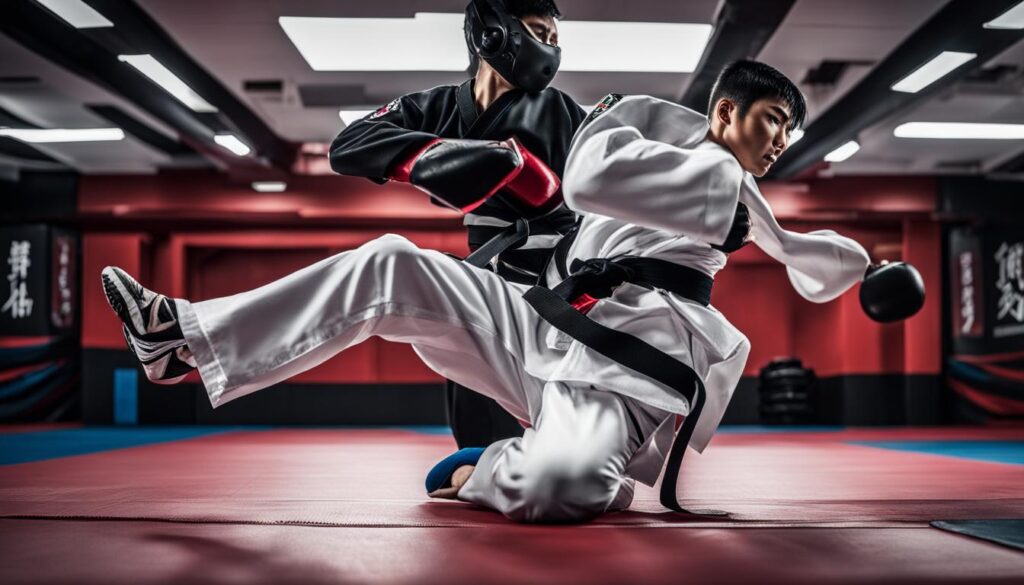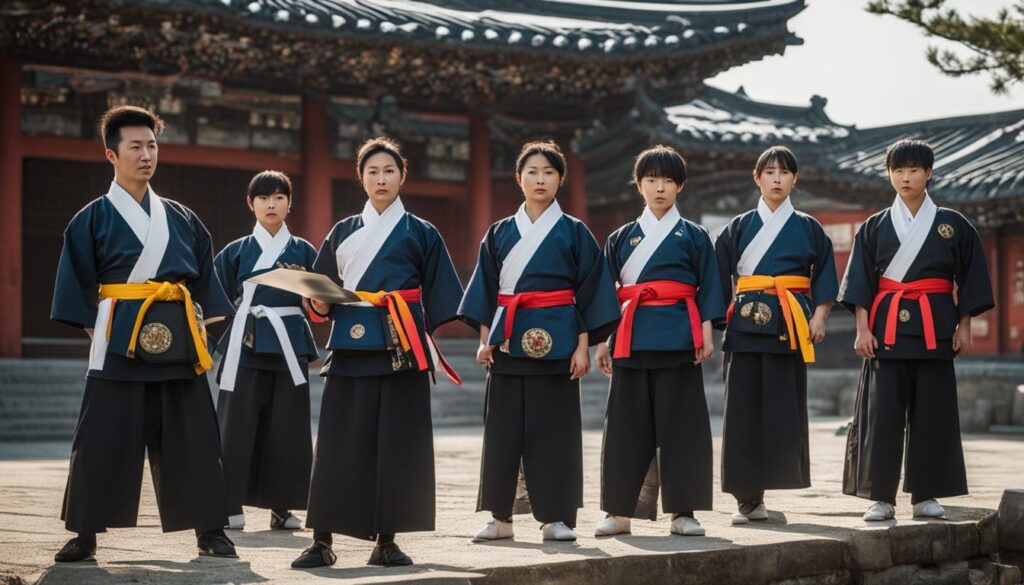Welcome to our guide on the various titles and ranks that exist within the world of Taekwondo. If you’ve ever been curious about the different names used to address Taekwondo instructors, this article is for you. Let’s dive right in!
In Taekwondo, the correct term for an instructor is 사범 (sabom), pronounced sah-bom. This title is used to show respect and is equivalent to “teacher” or “coach” in English. It is important to note that the term “sensei,” commonly used in Japanese martial arts, should not be used in Taekwondo.
To show respect when addressing a Taekwondo instructor, the suffix 님 (nim) is added. For example, a student might say “Sabomnim, can you teach me the form Wonhyo?” This shows both respect and recognition of the instructor’s expertise.
Now that we have a better understanding of the appropriate titles to use, let’s explore the ranks that Taekwondo instructors can achieve.
Key Takeaways:
- Taekwondo instructors are addressed as “sabom” and should be shown respect by adding the suffix “nim” to their title.
- The term “sensei” is used in Japanese martial arts and should not be used in Taekwondo.
Taekwondo Instructor Ranks
Taekwondo is a martial art that follows a hierarchical structure, with different ranks denoting levels of expertise and mastery. In Taekwondo, the ranking system is based on the Sino-Korean numbering system for dan ranks. Here are the typical dan ranks in Taekwondo:
| Dan Rank | Title |
|---|---|
| 1st Dan | Sabumnim |
| 2nd Dan | Sabumnim |
| 3rd Dan | Sabumnim |
| 4th Dan | Sabumnim |
| 5th Dan | Master |
| 6th Dan | Master |
| 7th Dan | Master |
| 8th Dan | Grandmaster |
| 9th Dan | Grandmaster |
| 10th Dan | Chief Master |
These ranks represent years of training and dedication, and each rank carries different responsibilities and expectations within the Taekwondo community. As practitioners advance in rank, they are entrusted with a greater role in teaching and guiding other students. The highest rank, Chief Master, represents the pinnacle of achievement in Taekwondo, demonstrating exceptional skill, knowledge, and leadership in the martial art.
Understanding Taekwondo Rank Terminology
In the world of Taekwondo, understanding the terminology associated with rank is essential. From the bo-dan rank to the yudanja rank, each term carries symbolic meaning within the martial art. Additionally, the poom rank provides an alternative for young practitioners who have yet to reach the age of 15. Let’s explore these rank terminologies in more detail.
Firstly, when a candidate achieves a black belt in Taekwondo, they are said to have attained the rank of dan bo nim. This rank is commonly referred to as bo-dan or bo-black. It represents a significant milestone in a practitioner’s journey, signifying their dedication and skill.
Those who have achieved a dan rank are often referred to as yudanja. The term yudanja recognizes their elevated status as black belt holders and acknowledges their expertise in Taekwondo.
However, in some Korean schools, young practitioners who have not yet reached the age of 15 can achieve a poom rank instead of a dan rank. The poom rank serves as an intermediate step, allowing these young individuals to progress and experience the benefits of climbing the ranks. Poom ranks are typically denoted by a black belt with a red stripe, distinguishing them from the traditional black belt holders.
Understanding these Taekwondo rank terminologies is crucial for both practitioners and enthusiasts. They reflect the hierarchical structure and the journey undertaken by individuals in their pursuit of mastery in this martial art. Whether one holds the esteemed bo-dan rank, is referred to as yudanja, or has achieved the poom rank at a young age, each designation represents a significant milestone and holds deep meaning within the Taekwondo community.
Symbolism of the Black Belt in Taekwondo
The black belt in Taekwondo holds great symbolism and carries deep meaning within the martial art. It represents the culmination of years of training, discipline, and dedication. The progression from lower ranks to the coveted black belt symbolizes the practitioner’s journey towards mastery.
Black, a color commonly associated with strength and power, represents the wearer’s level of proficiency and expertise. It signifies the individual’s ability to demonstrate a high level of skill, knowledge, and understanding of all previously learned forms and techniques.
While black can have negative connotations in certain contexts, such as death, in Taekwondo, it embodies the wearer’s personal growth, resilience, and accomplishment. The black belt is a symbol of maturity, both physically and mentally, reflecting the practitioner’s continuous development and evolution.
As the highest attainable rank for many martial arts disciplines, the black belt serves as a mark of respect and admiration from fellow practitioners, instructors, and the wider Taekwondo community. It commands authority and signifies the wearer’s role as a role model and mentor to others.
The journey towards achieving a black belt is not solely about physical prowess but also encompasses the development of character, discipline, perseverance, and indomitable spirit. It represents a commitment to self-improvement, self-control, and the pursuit of excellence in all aspects of life.

| Symbolism of the Black Belt in Taekwondo |
|---|
| Maturity and proficiency in forms and techniques |
| Years of training and dedication |
| Mastery and experience |
| Resilience and personal growth |
| Authority and respect within the community |
| Development of character and discipline |
| Commitment to self-improvement and excellence |
Adornment and Decoration of the Black Belt in Taekwondo
In the world of Taekwondo, the black belt holds significant importance as a symbol of achievement and mastery. Many practitioners take pride in adorning and decorating their black belts, adding a personal touch to this coveted martial arts accessory.
One popular way to customize a black belt is through embroidery. Embroidery allows practitioners to add meaningful lettering and symbols that represent their journey in Taekwondo. The adornments can include the practitioner’s name, the school’s name or logo, the rank awarded, the date awarded, and even the name of the master who bestowed the rank.
Embroidery on the black belt is typically done in the school’s native language and Korean, using intricate gold thread to create a visually striking design. This artful decoration not only adds aesthetic appeal but also serves as a reminder of the practitioner’s dedication and accomplishments.
The customization options for the black belt are endless, allowing practitioners to express their individuality while maintaining the traditional essence of Taekwondo. Some may choose to incorporate additional elements such as patterns or motifs that hold personal significance to further personalize their black belt.
Teacher Roles in Korean Martial Arts
In Korean martial arts, such as Taekwondo, there are four primary teacher roles that play a crucial part in the development of practitioners. These roles are:
- Kyosanim: The Kyosanim is the term used to refer to the instructor or teacher. They are responsible for providing guidance, teaching techniques, and overseeing the progress of their students. Kyosanims are highly skilled and experienced practitioners who have dedicated themselves to the art.
- Sabomnim: The Sabomnim is a higher-level instructor, often regarded as a master or senior instructor. They have an extensive knowledge of the martial art and are entrusted with teaching advanced techniques to more experienced students. Sabomnims are respected figures who are looked up to by both students and other instructors.
- Kwanjangnim: The Kwanjangnim is the head instructor or the owner of a martial arts school. They oversee the entire operation of the school, including curriculum development, student management, and instructor training. Kwanjangnims have achieved a high level of mastery in the martial art and are responsible for maintaining the school’s integrity and reputation.
- Dojunim: The Dojunim is the highest-ranking authority in a specific style or lineage of the martial art. They hold immense knowledge and expertise and are often considered the founder or the guiding force behind the style. Dojunims are esteemed figures and serve as a source of inspiration and guidance for practitioners.
Each of these teacher roles has unique responsibilities and influences the training and development of martial arts practitioners. They create a structured learning environment and help students progress through their martial arts journey.

Conclusion
Understanding the various titles and ranks in Taekwondo is crucial for practitioners to uphold respect and navigate the hierarchical structure of this martial art. From instructors to sabomnims, each role serves a specific function and contributes to the growth of the practitioner. By familiarizing oneself with the terminology and symbolism associated with Taekwondo, practitioners can deepen their understanding and appreciation for this art form.
By recognizing the significance of instructors and their titles, practitioners can show proper respect and gratitude for their guidance. Knowing the different ranks within Taekwondo allows practitioners to set goals and track their progress as they advance through the dan ranks. The symbolism of the black belt reflects the dedication and mastery achieved through years of training.
Furthermore, adorning the black belt with personalized embroidery adds a unique touch and serves as a reminder of the practitioner’s accomplishments. The embroidery often includes the practitioner’s name, date of rank, and the name of the master who awarded it. These personalized details create a sense of pride and honor within the practitioner.
Ultimately, understanding the titles, ranks, terminology, and symbolism in Taekwondo enhances one’s knowledge and appreciation for this martial art form. It allows practitioners to navigate the hierarchical structure and show respect to their instructors. By delving into the rich history and principles of Taekwondo, practitioners can embrace the depth and beauty of this traditional Korean martial art.
FAQ
What is a Taekwondo instructor called?
A Taekwondo instructor is called a “sabom” or “sabomnim”.
Can a Taekwondo instructor be called a sensei?
No, the term “sensei” is used in Japanese martial arts and should not be used in Taekwondo.
How should I address my Taekwondo instructor?
To show respect, you can address your Taekwondo instructor as “Sabomnim” followed by their name. For example, you may say “Sabomnim, can you teach me the form Wonhyo?”
What are the dan ranks in Taekwondo?
The dan ranks in Taekwondo are a system of ranking for black belts. The typical dan ranks include 1st dan, 2nd dan, 3rd dan, and so on.
What is a bo-dan in Taekwondo?
A bo-dan in Taekwondo refers to a candidate for a black belt. It is a rank commonly associated with black belt candidates.
What is a yudanja in Taekwondo?
In Taekwondo, those who have received a dan rank (black belt) are sometimes referred to as yudanja.
What is a poom rank in Taekwondo?
In some Korean schools, young practitioners who have not yet reached the age of 15 can achieve a poom rank instead of a dan rank. Poom ranks are typically denoted by a black belt with a red stripe.
What does the black belt symbolize in Taekwondo?
The black belt in Taekwondo symbolizes maturity and proficiency in all previously learned forms and techniques. It represents the culmination of years of training and dedication.
How can I adorn my black belt in Taekwondo?
Many Taekwondo practitioners choose to adorn their black belts with embroidered lettering and symbols. These adornments may include the practitioner’s name, the school’s name or logo, the awarded rank, the date awarded, and the name of the master who awarded the rank.
What are the primary teacher roles in Korean martial arts?
The primary teacher roles in Korean martial arts, including Taekwondo, are Kyosanim, Sabomnim, Kwanjangnim, and Dojunim.
Why is it important to understand the titles and ranks in Taekwondo?
Understanding the various titles and ranks in Taekwondo is important for practitioners to show respect and navigate the martial art’s hierarchical structure. It deepens one’s understanding and appreciation for this martial art form.
